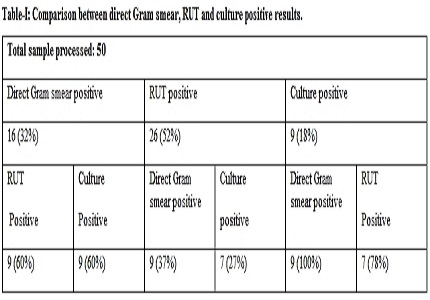Correlation of Helicobacter pylori infections in patients of dyspepsia with or without ulcer with endoscopic findings
Abstract
Introduction: Since the discovery of H. pylori in 1983, the diagnosis and treatment of upper gastrointestinal diseases have changed greatly. A higher risk of the development of gastric cancer has been reported in subjects with positive serologic tests for H. pylori.
Aims: Isolation of Helicobacter pylori from dyspeptic patient with or without ulcer and its correlation with endoscopic findings.
Settings and Design: Prospective cross sectional study.
Methods and Material: The study was conducted in the Department of Microbiology, SMIMS, Tadong, Gangtok for a period of 1 year (01.05.2013 – 30.04.2014) with patients with symptoms of dyspepsia. The parameters of investigation included upper gastrointestinal endoscopy, rapid urease test, Gram smear examination and isolation & identification of H. pylori by cultural technique.
Results: Out of 50 patients, 32(64%) were positive for H. pylori by any of the three parameters. Of these, 26 (52%) were positive by RUT, 16(32%) by direct Gram stained smears, and 9(18%) by culture. Out of 50 samples, 9 (18%) were positive by both RUT and direct Gram smear microscopy, 7 (14%) by both RUT and culture, 9 (18%) by both direct Gram smear microscopy and culture and 7 (14%) by all the three methods.
Discussion: The results revealed that the RUT should not be a sole criterion for diagnosis of dyspepsia associated by H. pylori. Culture is probably the most difficult approach to the diagnosis of H. pylori, however, it is considered as gold standard, highly specific and also antibiotic sensitivity can be detected.
Conclusions: Among the endoscopic findings, esophagitis cases revealed 100% positive result by all the three parameters, while duodenitis, antroduodenitis and antral gastritis showed, 57%, 50% and 38.4% positive result by any of the three parameters. Considering our results it reveals that there is much correlation between esophagitis and H. pylori infection.
Downloads
References
2. Parsonnet J, Friedman GD, Vandersteen DP, Chang Y, Vogelman JH, Orentreich N, Sibley RK. Helicobacter pylori infection and the risk of gastric carcinoma. N Engl J Med. 1991 Oct 17;325(16):1127-31. [PubMed]
3. Nomura A, Stemmermann GN, Chyou PH, Kato I, Perez-Perez GI, Blaser MJ. Helicobacter pylori infection and gastric carcinoma among Japanese Americans in Hawaii. N Engl J Med. 1991 Oct 17;325(16):1132-6.
4. Forman D, Newell DG, Fullerton F, Yarnell JW, Stacey AR, Wald N, Sitas F. Association between infection with Helicobacter pylori and risk of gastric cancer: evidence from a prospective investigation. BMJ. 1991 Jun 1;302(6788):1302-5.
5. Huang JQ, Sridhar S, Chen Y, Hunt RH. Meta-analysis of the relationship between Helicobacter pylori seropositivity and gastric cancer. Gastroenterology. 1998 Jun;114(6):1169-79.
6. Nardone G. Compare D. De Colibus P. De Nucci G. Rocco A. Helicobacter pylori and Epigenetic Mechanisms Underlying Gastric Carcinogenesis. Dig Dis. 2007;25:225–229 (DOI:10.1159/000103890)
7. Yuki Obata, Shogo Kikuchi, Hiroto Miwa, Kiyoko Yagyu, Yingsong Lin and Atsushi Ogihara. Diagnostic accuracy of serological kits for Helicobacter pylori infection with the same assay system but different antigens in a Japanese patient population. Journal of Medical Microbiology. 2003;52:889–892 DOI 10.1099/jmm.0.05267-0 05267 & 2003.
8. Ohara S, Kato M, Asaka M, Toyota T. Studies of 13C-urea breath test for diagnosisof Helicobacter pylori infection in Japan. J Gastroenterol. 1998;33:6–13. 9.
9. Tabata H, Fuchigami T, Kobayashi H, Sakai Y, Nakanishi M, Tomioka K, Nakamura S, Fujishima M. Helicobacter pylori and mucosal atrophy in patients with gastric cancer: a special study regarding the methods for detecting Helicobacter pylori. Dig Dis Sci. 1999 Oct;44(10):2027-34.
10. McQuaid KR, McPhee SJ, and Papadakos M A. Current Medical Diagnosis and Treatment. 49th edition, New York: Mc Graw- Hill. 2010. p.500-597.
11.Sengupta S, Saraswathi K, Varaiya A, De A, Gogate A. Helicobacter pylori in duodenal ulcer disease and its eradication. Indian J Med Microbiol. 2002 Jul-Sep;20(3):163-4. [PubMed]
12. Moss S, Calam J. Helicobacter pylori and peptic ulcers: the present position. Gut. 1992 Mar;33(3):289-92. [PubMed]
13. Borody TJ, Andrews P, Mancuso N, McCauley D, Jankiewicz E, Ferch N, Shortis NP, Brandl S. Helicobacter pylori reinfection rate, in patients with cured duodenal ulcer. Am J Gastroenterol. 1994 Apr;89(4):529-32. [PubMed]
14. U Arora, A Aggarwal, K Singh. Comparative evaluation of conventional methods and elisa based IgG antibodies detection for diagnosis of helicobacter pylori infection in cases of dyspepsia. Indian J Med Microbiol 2003; 21(1): 46-48.
15. Sengupta S, Saraswathi K, Varaiya A, De A, Gogate A. Helicobacter pylori in duodenal ulcer disease and its eradication. Indian J Med Microbiol. 2002 Jul-Sep;20(3):163-4. [PubMed]
16. V. Subbukesavraja, K. Balam. Comparitive study of invasive methods for diagnosis of Helicobacter pylori in humans. Int.J.Curr.microbio.App.Sci. 2013; 2(7): 63-68.
17. Prasad KN, Singhal S, Ayyagari A, Sharma S, Dhole TN. Association of Helicobacter pylori in patients of Non ulcer dyspepsia. Indian J Med Microbiol. 1991;31:415-418.
18. Malik A, Singhal S, Mukharji U. Evaluation of ELISA based antibody test against H. pylori in cases of non ulcer dyspepsia. Indian J Med Microbiol. 1999;17:137-139.
19. Nanivadekar SA, Sawant PD, Saraswathi K, Shroff CP, Bichile LS, Patel HD, Shroff DS. Association of Campylobacter pylori with gastritis, duodenal ulcer and gastric ulcer--a preliminary report of dyspeptic patients. Indian J Gastroenterol. 1988 Jul;7(3):141-2.
20. Karnes WE Jr, Samloff IM, Siurala M, Kekki M, Sipponen P, Kim SW, Walsh JH. Positive serum antibody and negative tissue staining for Helicobacter pylori in subjects with atrophic body gastritis. Gastroenterology. 1991 Jul;101(1):167-74.
21. Iwahi T, Satoh H, Nakao M, Iwasaki T, Yamazaki T, Kubo K, Tamura T, Imada A. Lansoprazole, a novel benzimidazole proton pump inhibitor, and its related compounds have selective activity against Helicobacter pylori. Antimicrob Agents Chemother. 1991 Mar;35(3):490-6.



 OAI - Open Archives Initiative
OAI - Open Archives Initiative


